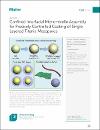Confined Interfacial Monomicelle Assembly for Precisely Controlled Coating of Single-Layered Titania Mesopores
| Author | Lan K. |
| Author | Xia Y. |
| Author | Wang R. |
| Author | Zhao Z. |
| Author | Zhang W. |
| Author | Zhang X. |
| Author | Elzatahry A. |
| Author | Zhao D. |
| Available date | 2020-04-27T08:34:17Z |
| Publication Date | 2019 |
| Publication Name | Matter |
| Resource | Scopus |
| ISSN | 25902393 |
| Abstract | The development of core-shell structures has been in great demand recently owing to their integrated functionalities. However, the progress in reliable coating of porous semiconductors remains unproductive. Here, we have demonstrated a confined interfacial monomicelle assembly method for controlled coating of ordered single-layered mesoporous TiO2. The coating method can be well controlled with tunable coated layers, mesopore size, and switchable coated surfaces. The resulting mesoporous TiO2 exhibit excellent electrochemical properties as a sodium-ion anode, which is attributed to their unique mesostructures associated with accessible high surface area and ultrathin layers. Such accurately designed mesoporous core-shell nanostructures are expected to provide a useful platform to produce numerous delicate core-shell nanostructures with integrated functionalities and mesoporosities for potential applications, such as catalysts, sensors, energy storage, and energy conversion. - 2019 Elsevier Inc.Mesoporous core-shell nanostructures have recently been receiving extensive scientific interest; however, reliable approaches for coating mesoporous materials still remain exciting challenges, except for amorphous silica. We report, for the first time, a confined interfacial monomicelle assembly method for controlled coating of anatase TiO2 with single-layered ordered mesopores on diverse surfaces, opening up the area of coating ordered mesoporous crystalline materials that possess mesopores originating from self-assembled surfactant instead of accumulated nanocrystals. This facile and repeatable methodology relies on the solvent-confinement effect of glycerol during the assembly process and monomicelle hydrogel preformation by selective evaporation of double-solvent precursors. This assembly process shows precise controllability and great versatility, endowing the coated TiO2 layers with highly tunable thickness, mesopore size, and switchable coated surfaces. The ultrathin monolayered mesopores of such mesoporous TiO2 shells, in combination with their high surface area and highly crystalline nature, afford them excellent rate capability and superior cyclability for sodium-ion storage. - 2019 Elsevier Inc.We have demonstrated a confined interfacial monomicelle assembly approach for accurately coating ordered monolayered TiO2 mesopores on diverse surfaces. By regulating the synthetic conditions, the coated mesoporous TiO2 layers can be well controlled with desired thickness, mesopore size, and switchable coated surfaces. The resulting monolayered mesoporous TiO2 exhibit excellent sodium-storage properties. This unique mesoporous TiO2 coating strategy affords great potential in constructing multicomponent nanostructures with mesoporosities for advanced technologies. - 2019 Elsevier Inc. |
| Sponsor | This work is supported by the State Key Basic Research Program of China ( 2017YFA0207303 ), the National Natural Science Foundation of China ( 21733003 ), the Shanghai Leading Academic Discipline Project ( B108 ), and the Science and Technology Commission of Shanghai Municipality ( 17JC1400100 ). K.L. acknowledges the financial support by the China Scholarship Council ( 201806100112 ). A.E. acknowledges Qatar University under GCC Co-Fund Program grant GCC-2017-001 . |
| Language | en |
| Publisher | Cell Press |
| Subject | core shell interfacial assembly MAP 3: Understanding mesoporous materials sodium storage TiO2 |
| Type | Article |
| Pagination | 527-538 |
| Issue Number | 2 |
| Volume Number | 1 |
Files in this item
This item appears in the following Collection(s)
-
Materials Science & Technology [310 items ]


